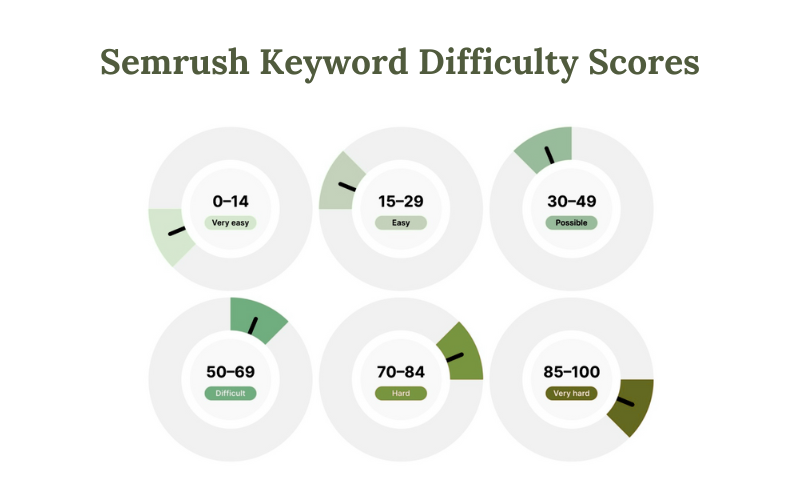Finding keywords with high traffic potential is simple, but figuring out if you can actually rank for them? That’s the real challenge.
That’s where keyword difficulty comes into play. SEO tools like Semrush assign a difficulty score ranging from 0 to 100 to help you gauge how tough it might be to rank for a particular keyword.
But let’s be real here – these scores aren’t always spot-on. Therefore, in this post, we’ll walk you through the pros and cons of the keyword difficulty metrics.
What Is Keyword Difficulty?
Keyword difficulty is basically a way to figure out how tough it is to snag a top spot in search results without paying for it. Let’s say you’re gunning for the keyword “macbook.” That’s a tough nut to crack because you’ve got giants like Apple dominating the search scene with top-notch content.
In tools like Semrush, they measure keyword difficulty using a percentage. The higher the percentage, the harder it is to rank. So, if a keyword has a 100% difficulty score, you better brace yourself because it’s going to be an uphill battle to beat out the competition.

Why Is Keyword Difficulty Important?
Understanding keyword difficulty is a big deal in SEO. It’s like your secret weapon for figuring out which search terms you could totally rock in search engine results.
Basically, it helps you pinpoint those golden keywords that could bring in heaps of traffic to your site. And who doesn’t want more eyeballs on their content, right?
When you snag those top spots in the unpaid search results, you’re basically rolling out the red carpet for clicks. And more clicks usually mean more conversions and better business outcomes. Cha-ching!
Plus, you can mix and match difficulty scores with other juicy insights to cherry-pick the absolute best keywords for your content game plan. It’s like putting together the perfect puzzle for your SEO success.
What Affects Keyword Difficulty In SEO?
Keyword difficulty metric tells you how tough it is to rank for a particular keyword. It basically checks out the top 10 results on Google and analyze a bunch of stuff about the keyword itself. Let me break down six important factors for you.
Backlinks To Top Ranking Sites
Backlinks, in simple terms, are like referrals for websites. When another site links to yours, it’s like a vote of confidence. Now, Google really values certain types of backlinks, seeing them as strong endorsements. So, here’s the deal: the more powerful the backlinks of those top-ranking sites are, the tougher it gets in terms of keyword difficulty.
Now, let’s talk about how we gauge keyword difficulty, and it mainly looks at two backlink metrics:
- The median number of referring domains – This basically means how many different websites are giving a thumbs-up to the site in question. The more sites that vouch for it, the more Google sees it as a big deal. And guess what? It’s going to be tougher to outshine these well-supported sites.
- The median ratio of follow to nofollow link –. Nofollow links are like whispers in the wind – search engines are asked to ignore them. So, if a site has a low number of these nofollow links compared to the ones search engines pay attention to (the follow links), it’s like it’s speaking louder in the digital conversation. And that can make it a real challenge to beat in the rankings.
Authority Scores Of Top Ranking SItes
Authority Score is like a report card for websites, grading how good they are at SEO. They rate it on a scale from 1 to 100, and it’s based on three main things:
- Link power: This is all about the quality and quantity of backlinks pointing to a site. The more reputable and numerous the backlinks, the better.
- Organic traffic: This measures the estimated number of visits a site gets from search engines each month, without paying for ads. The more, the merrier!
- Natural profile: This looks at how clean a site’s backlink profile is. If it’s got a lot of spammy links pointing to it, that’s not good. You can dig deeper into this in our guide on toxic backlinks.
Now, here’s the kicker: the higher the Authority Scores of the top-ranking sites for a keyword, the tougher the keyword difficulty. It’s like the higher the bar is set, the harder it is to climb over.
Keyword Seach Volume
When we talk about search volume, we’re basically referring to how many times a keyword gets searched for each month. And here’s the thing: the more searches a keyword gets, the tougher it tends to be to rank for it. Why’s that? Well, because those high-volume keywords have the potential to bring in loads of traffic, and everyone wants a piece of that pie!
Now, the trick is to find those high-volume keywords that you can realistically compete for. It’s like aiming for the sweet spot where you can attract a good amount of traffic without having to battle against too many competitors.
But what’s “achievable” varies depending on your website’s standing and your content strategy. It’s all about finding the balance between high search volume and manageable keyword difficulty to drive the right kind of traffic to your site.
Presence of SERP Features
When you search for something online, you might have noticed certain results that really pop out. These are called SERP features, and they’re not your typical search results. They could be a featured snippet giving a quick answer, a local map pack, or even a knowledge panel on the side summarizing a topic.
Now, if the keyword you’re targeting triggers one of these fancy features, it usually means it’s going to be tougher for your website to get noticed organically. That’s what we call “keyword difficulty.” Essentially, the more of these special features show up, the harder it is to rank well on that keyword.
Let’s break down some of these SERP features:
- Featured snippet: This is like the cherry on top of the search results, appearing right at the very top and giving a snapshot of a webpage.
- Instant answer: Sometimes, you don’t even need to click a link because the answer shows up right there in the search results, like a dictionary definition.
- Local pack: If you’re searching for something location-specific, like a restaurant or a plumber, you’ll often see a map with businesses listed. That’s the local pack.
- Knowledge panel: Ever searched for a famous person or a popular place and seen a neat little summary pop up on the side? That’s the knowledge panel.
- Top stories: If your search is about something newsworthy, you might see a block with links to recent articles.
- People also ask: Google is great at guessing what else you might want to know, so it throws in a bunch of commonly asked questions.
- Sitelinks: Sometimes, Google likes a website so much it gives it some bonus links right below the main result.
Now, here’s the kicker: If your keyword doesn’t trigger any of these special features, it’s actually good news for your SEO efforts. It means you’re not competing with those flashy distractions, so your keyword difficulty score is likely to be lower.
Whether The Keyword Is Branded
So, let’s say you’re eyeing a keyword like “macbook” and it happens to include a brand name. In this case, the keyword difficulty for SEO is probably going to be higher.
Why? Because Google tends to give priority to results from the brand’s own website. This means it’s going to be tougher for other websites to snag those top spots in search results.
Take the example of Apple. If they’re all over the “macbook” search engine results page (SERP), it’s going to be pretty challenging for other sites to compete.
The Search Term’s Word Count
So, when it comes to our keyword difficulty metric, we’ve noticed something interesting: longer keywords tend to have lower difficulty scores. These longer ones are often what we call “long-tail keywords.” They’re super specific and usually don’t have as many searches or competition.
Let me give you an example:
- “Apple MacBook m3” has a difficulty rating of 65% and receives approximately 520 searches per month.
- “MacBook m3 16″ in Space Black” It has a lower difficulty score of 42% and gets around 290 searches per month.
These numbers illustrate how targeting specific variations like “MacBook m3 16″ in Space Black” with lower difficulty scores can still yield significant search traffic, making them valuable keywords to consider for your SEO strategy.
What Is A Good Keywrod Difficulty Score To Target?
In the world of SEO, it’s always a bit of a mixed bag:
- It depends on how authoritative your website is.
- It hinges on your credibility within a particular field.
- It’s affected by your ability to gather backlinks.
- And, of course, whether you can meet search intent with your content, among other factors.
One helpful move you can make is checking out the Keyword Difficulty (KD) scores for the keywords you’re already ranking for. It gives you a solid starting point. But remember, it’s not a one-size-fits-all solution. To really gauge your chances of ranking for a keyword, dive into analyzing the top-ranking pages and consider your own skills and resources.
And don’t let high-KD keywords scare you off. We’ve tackled plenty with a KD of 70+ over time, but it took multiple revisions, a ton of promotion, and a whole lot of patience. So, the sooner you set your sights on a high-KD keyword you’re eager to rank for, the sooner you can start making progress toward it.
How To Create Rankable Content
No matter how tough that keyword difficulty score looks, your ace in the hole is quality content. Yep, that’s the secret sauce. You gotta whip up content that not only meets what folks are looking for but does it in a way that’s smooth and snappy. That’s what we call satisfying search intent.
And hey, aiming for the stars? That’s the way to go. You want to be the shining star in your niche, right?
If you’re feeling a bit overwhelmed by all this, don’t sweat it. Margator has got your back with top-notch content development services. Let’s help you conquer that keyword difficulty and rise to the top!
Final Word
So there you have it, folks! Understanding keyword difficulty is like unlocking the secret sauce to conquering the search engine game. It’s not just about finding those high-traffic keywords but also about knowing if you can realistically snag a top spot.
Remember, it’s a balancing act between your website’s authority, your content’s relevance, and your SEO strategy. And if you’re feeling overwhelmed, don’t worry, that’s where Margator’s SEO services come in!Whether you’re just starting out or aiming for the top, The Margator has got your back. Let’s turn those high-KD keywords into your next big wins together. Ready to take your SEO game to the next level? Let’s get the ball rolling!

